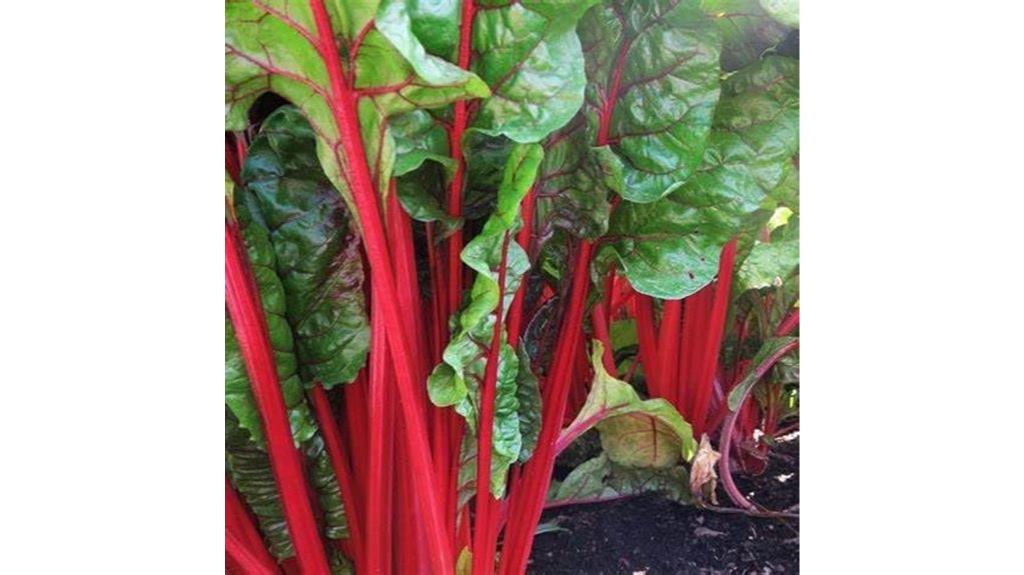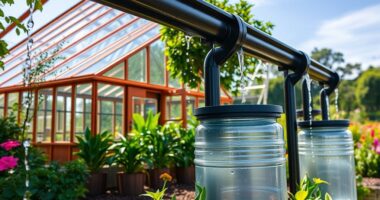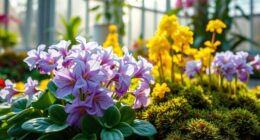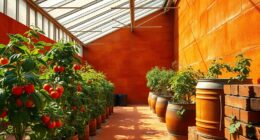When I cultivate Swiss chard, I focus on selecting non-GMO heirloom seeds for vibrant flavors. I make certain my plants get at least six hours of sunlight daily and use well-draining, nutrient-rich soil. Consistent moisture is essential, so I watch the watering closely. Also, I create space between plants for healthy growth and introduce beneficial insects to keep pests at bay. These tips have transformed my gardening experience, and if you want to know more, keep going!
Key Takeaways
- Choose Non-GMO heirloom seeds with high germination rates and vibrant varieties like Rainbow Swiss Chard for robust flavors and aesthetics.
- Ensure Swiss chard receives at least 6 hours of full sunlight daily, with well-draining soil rich in organic matter.
- Maintain consistent moisture without waterlogging, and space plants 12-24 inches apart for healthy growth.
- Monitor for pests and use beneficial insects like ladybugs, along with garden cloth covers to protect your plants.
- Harvest leaves regularly to encourage new growth and enjoy fresh Swiss chard in salads, soups, and smoothies.
100+ Heirloom Rainbow Mix Swiss Chard Seeds

If you’re looking for a vibrant and nutritious addition to your garden, the Heirloom Rainbow Mix Swiss Chard seeds are perfect for you. I love how easy they are to grow, making them ideal for beginners. With over 100 seeds, you’ll enjoy a stunning array of colors—red, orange, yellow, green, and purple. Not only do they provide essential vitamins A and K, but they’re also versatile in the kitchen. You can toss them in salads, soups, or even smoothies. Plus, with a satisfaction guarantee, you can’t go wrong. Trust me, once you try them, you’ll want to grow more!
Best For: Beginner gardeners looking for an easy-to-grow, colorful, and nutritious vegetable option.
Pros:
- Non-GMO seeds with a high germination rate.
- Versatile culinary uses for salads, soups, and smoothies.
- 100% satisfaction guarantee with a full refund option.
Cons:
- Some users reported inconsistent germination rates for specific colors.
- Requires garden cloth cover to deter pests, which may increase initial setup effort.
- Limited availability of specific colors may affect planting preferences.
Back to the Roots – 100% Organic Seed Packet – Swiss Chard Ruby Red 210mg

For gardeners seeking a reliable and vibrant addition to their vegetable patch, the Back to the Roots – 100% Organic Seed Packet featuring Swiss Chard Ruby Red is an excellent choice. This 210mg packet contains heirloom, non-GMO seeds that thrive in partial sun with moderate watering. I love that it’s perfect for container gardening, making it accessible for anyone, regardless of space. Plus, the GROWONEGIVEONE program encourages us to share our gardening journey, supporting education in our communities. While some reviews mention germination issues, many gardeners, including myself, have enjoyed success with these stunning ruby red leaves.
Best For: Gardeners looking for an easy-to-grow, vibrant vegetable that thrives in limited spaces and promotes community engagement.
Pros:
- 100% organic, non-GMO, and heirloom seeds ensure a healthy gardening experience.
- Suitable for container gardening, making it ideal for small spaces or urban gardens.
- GROWONEGIVEONE program encourages community involvement and supports educational initiatives.
Cons:
- Some users report germination issues, leading to inconsistent growth.
- Mixed reviews indicate varying experiences with plant health among different gardeners.
- Requires moderate watering, which may be challenging for some gardeners to manage consistently.
Sow Right Seeds Fordhook Swiss Chard Seed Packet for Planting

Sow Right Seeds Fordhook Swiss Chard Seed Packet is perfect for gardeners seeking a reliable, nutrient-packed addition to their vegetable patch. These non-GMO heirloom seeds offer a generous 2-gram packet, containing about 80 seeds. I love how the large, savoyed leaves with white veins create a stunning visual in my garden. Germination takes just 7-14 days at the right soil temperature, and they thrive in full sun. With a maturity of 50-60 days, I enjoy the delicious, spinach-like flavor in my meals. Plus, their hardiness makes them suitable for a wide range of USDA zones, ensuring a successful harvest.
Best For: Gardeners looking for a hardy, nutrient-dense leafy green that is easy to grow and perfect for various climates.
Pros:
- Nutrient-rich: Packed with vitamins and minerals, making it a healthy addition to meals.
- Quick germination: Seeds typically germinate within 7-14 days, allowing for fast growth.
- Versatile growing conditions: Suitable for a wide range of USDA zones (3-12), making it adaptable to different climates.
Cons:
- Potential growth issues: Some users report challenges with the growth of the plants after germination.
- Requires full sun: Needs specific sunlight conditions, which may not be ideal for all garden locations.
- Limited packet size: While it contains about 80 seeds, larger gardens may require multiple packets for sufficient planting.
Rainbow Swiss Chard Seeds for Planting (50 Seeds)

Rainbow Swiss Chard seeds are perfect for gardeners looking to add vibrant colors and rich flavors to their plots. Each packet contains 50 heirloom, non-GMO seeds, ensuring a premium gardening experience. I love that they thrive in zones 6 and up, making them versatile for many climates. With a quick harvest time of around 60 days, you’ll enjoy fresh greens in no time. The variety of colors adds a delightful visual appeal to my garden. Plus, the clear instructions make planting straightforward. Just remember to monitor soil moisture and temperature for the best germination results. Happy gardening!
Best For: Gardeners looking to enhance their plots with colorful, flavorful greens that are easy to grow and harvest.
Pros:
- Premium quality heirloom, non-GMO seeds for a reliable gardening experience.
- Quick harvest time of approximately 60 days, allowing for early enjoyment of fresh greens.
- Vibrant colors of the Rainbow Mixture add visual appeal to any garden.
Cons:
- Some reports of stunted growth and poor germination rates from certain users.
- Requires careful monitoring of soil moisture and temperature for optimal results.
- Best suited for specific growing zones, limiting its versatility in colder climates.
Sow Right Seeds Swiss Chard Collection for Planting

If you’re looking to elevate your home garden with vibrant greens, the Sow Right Seeds Swiss Chard Collection is an excellent choice for both novice and experienced gardeners. This collection features Rainbow and Fordhook Swiss Chard, both Non-GMO heirloom varieties that thrive in vegetable gardens. I love how these seeds produce large, colorful leaves that not only enhance my garden’s aesthetics but also provide delicious, nutritious greens for my meals. Each packet comes with easy growing instructions, and their commitment to sustainability reassures me about the quality. Plus, their customer support is always there if I have questions!
Best For: Home gardeners looking for vibrant, nutritious greens that are easy to grow and add visual appeal to their gardens.
Pros:
- High-quality Non-GMO heirloom seeds that produce beautiful, large leafy greens.
- Versatile culinary uses, perfect for salads, quiches, stir fries, and more.
- Strong customer support and guaranteed germination for peace of mind.
Cons:
- Limited to only two varieties (Rainbow and Fordhook Swiss Chard) in the collection.
- Requires specific growing conditions to thrive, which may not suit all garden environments.
- May attract pests if not properly maintained, requiring additional attention.
The Old Farmers Almanac Heirloom Swiss Chard Seeds (Rainbow Mixture) – Non-GMO, USA Origin

For gardeners seeking vibrant colors and diverse flavors in their vegetable patch, The Old Farmers Almanac Heirloom Swiss Chard Seeds (Rainbow Mixture) stand out as an excellent choice. This non-GMO, USA origin seed pack contains about 120 seeds with stunning red, yellow, pink, white, and orange stems. I love that these plants are not only drought-tolerant but also thrive in full sun and clay soil. They’re perfect for salads, soups, or even as ornamental features. With good germination rates and vigorous growth reported, I highly recommend these seeds for a bountiful harvest in your home garden!
Best For: Home gardeners looking for vibrant, flavorful vegetables that are easy to grow and drought-tolerant.
Pros:
- Non-GMO and heirloom variety ensures high-quality seeds.
- Suitable for both culinary uses and as decorative plants in gardens.
- Strong germination rates and vigorous growth reported by users.
Cons:
- Some users experienced spotty germination.
- May require specific soil conditions (clay soil) for optimal growth.
- Growth success can vary based on individual gardening conditions.
Organo Republic Swiss Chard Fordhook Seeds Pack (3.75 g)

Looking to elevate your gardening game? I highly recommend the Organo Republic Swiss Chard Fordhook Seeds Pack. With 3.75 g of over 200 Non-GMO heirloom seeds, these chard varieties promise robust flavors and stunning colors for your dishes. The innovative packaging protects the seeds from sunlight and moisture, ensuring they stay fresh for up to two years. Plus, with a high germination rate of over 90%, you can expect quick results. The included tips and QR codes lead you to an extensive growing guide, making it easy to cultivate this nutritious vegetable in various conditions. Happy gardening!
Best For: Gardening enthusiasts and home cooks looking to grow flavorful and vibrant Swiss chard in their gardens or hydroponic setups.
Pros:
- High germination rate of over 90%, ensuring successful growth.
- Non-GMO heirloom seeds provide robust flavors and beautiful colors.
- Innovative packaging protects seeds from sunlight and moisture for long-term storage.
Cons:
- Limited to Swiss chard, may not satisfy those looking for a wider variety of vegetables.
- Requires specific growing conditions for optimal results, which may not be suitable for all gardeners.
- Seeds have a viability period of up to 2 years, which may not appeal to those wanting immediate planting.
Sow Right Seeds Rainbow Swiss Chard Seeds for Planting

Sow Right Seeds Rainbow Swiss Chard Seeds are perfect for anyone wanting to add a burst of color and nutrition to their garden. These non-GMO heirloom seeds produce vibrant stalks in shades of green, red, gold, and magenta. I love how they grow quickly—ready to harvest in just 55-65 days. They thrive in full sun and can tolerate both heat and cold, making them versatile for various climates. With a minimum of 140 seeds per packet, I find it easy to plant them in garden beds or containers. They’re not just beautiful; they’re packed with vitamins, too!
Best For: Gardeners looking to enhance their garden with colorful, nutritious vegetables that are easy to grow and quick to harvest.
Pros:
- Vibrant Colors: Produces stunning stalks in multiple shades, adding visual appeal to any garden.
- Quick Growth: Matures in just 55-65 days, allowing for fast harvesting.
- Nutrient-Rich: Packed with vitamins and minerals, making it an excellent choice for health-conscious cooks.
Cons:
- Space Requirements: Needs adequate spacing of 12-14 inches apart, which may limit planting density.
- Sunlight Needs: Requires full sun, which may not be suitable for shaded gardens.
- Temperature Sensitivity: While hardy, extreme temperature fluctuations may affect growth if not properly managed.
Survival Garden Seeds – Rainbow Swiss Chard Seed for Planting

Survival Garden Seeds’ Rainbow Swiss Chard seeds are perfect for home gardeners seeking a vibrant and nutritious addition to their vegetable patch. This heirloom, non-GMO variety features stunning dark green leaves with colorful stalks in shades of green, white, magenta, and yellow. I love that these seeds thrive in hot weather, and their impressive germination rates of nearly 90% to 100% make planting a breeze. Each packet comes with clear instructions, and you can store the seeds for future use. I’ve enjoyed quick harvests, and it’s great knowing I’m supporting a dedicated, family-owned business with every sowing!
Best For: Home gardeners looking for a vibrant, nutritious, and easy-to-grow vegetable option.
Pros:
- High germination rates of nearly 90% to 100%, ensuring successful planting.
- Colorful and nutritious leaves that add aesthetic appeal and health benefits to meals.
- Detailed planting and growing instructions included, making it beginner-friendly.
Cons:
- Some users report challenges with germination due to environmental factors.
- Requires warm weather to thrive, which may limit growing seasons in cooler climates.
- Limited to a specific type of vegetable, which may not meet all gardening preferences.
Outsidepride 1000 Seeds Beta Vulgaris Red Swiss Chard Seeds for Planting

For gardeners enthusiastic to add vibrant color and nutrition to their plots, the Outsidepride 1000 Seeds Beta Vulgaris Red Swiss Chard Seeds offer an excellent choice. These heirloom seeds produce stunning ruby red stems paired with lush green leaves, making your garden both beautiful and productive. I love how easy they are to grow; just plant 2-3 seeds per spot in loamy soil and give them full sun. Within 50 to 60 days, you can start harvesting those outer stems. Plus, the positive customer feedback highlights their excellent germination rates and delicious flavor, which makes them a must-have!
Best For: Gardeners looking to grow vibrant and nutritious vegetables in their home gardens.
Pros:
- High germination rates: Many customers report successful sprouting and growth.
- Aesthetic appeal: The striking ruby red stems and green leaves enhance garden beauty.
- Culinary versatility: Leaves can be cooked like spinach and stalks like asparagus, adding flavor to various dishes.
Cons:
- Short shelf life: Harvested chard should be consumed quickly for best quality.
- Moderate watering needs: Requires consistent moisture, which may be challenging in drier climates.
- Biennial growth habit: While productive, it may not produce the same quantity year after year.
300 Ruby Swiss Red Chard Seeds for Planting

If you’re looking to add a vibrant touch to your garden, Ruby Swiss Red Chard seeds are an excellent choice for any home gardener. These non-GMO, heirloom seeds produce stunning dark green leaves with striking ruby red stalks. In just 55 days, you can enjoy a fresh, slightly bitter flavor, perfect for salads or steaming. I love that they yield throughout summer into fall, letting me harvest individual stems as needed. They thrive in full sun and require regular watering. With 300 seeds in a pack, you’ll have plenty to create a colorful and tasty addition to your vegetable garden!
Best For: Home gardeners looking to add a vibrant and nutritious vegetable to their garden.
Pros:
- Non-GMO and heirloom variety, ensuring high-quality seeds.
- Quick maturity time of 55 days allows for early harvesting.
- Continuous yield throughout summer into fall, providing fresh greens over an extended period.
Cons:
- Mixed reviews on germination rates, with some users reporting low success.
- Requires consistent watering and full sun exposure, which may be challenging in certain climates.
- Customer ratings are average, indicating some dissatisfaction with the product.
300 Lucullus Swiss Chard Seeds for Planting

Lucullus Swiss Chard seeds are an excellent choice for gardeners looking to enhance their survival vegetable gardens. With 300 non-GMO heirloom seeds, I can expect a bountiful harvest in just 50 days. The large green leaves and crunchy white stems are perfect for steaming or tossing in salads. To grow them successfully, I make sure my soil is rich and loose, with a pH of 6-6.4. I sow the seeds ¼ inch deep, spacing them 18-24 inches apart in full sun. Regular watering keeps them thriving, and I love that I can harvest continuously throughout summer!
Best For: Gardeners looking to cultivate a nutritious and resilient vegetable crop for survival gardens.
Pros:
- Non-GMO and heirloom variety ensures natural growing without genetic modifications.
- Quick harvest time of just 50 days allows for fast returns on gardening efforts.
- Versatile use in meals, ideal for steaming or adding to salads.
Cons:
- Requires specific soil conditions (pH 6-6.4) which may necessitate amendments for some gardeners.
- Full sun exposure is essential, limiting growing options in shaded areas.
- Continuous harvesting may lead to overharvesting if not managed properly, affecting future yields.
Red Ruby Swiss Chard Seeds – 300+ Heirloom Seeds Per Packet

Red Ruby Swiss Chard Seeds offer an exceptional choice for home gardeners looking to cultivate a vibrant and delicious crop. With over 300 heirloom seeds per packet, these non-GMO gems are perfect for both novice and experienced gardeners alike. I love sowing them ½ inch deep in compost-enriched soil after the last spring frost, spacing them 4-5 inches apart for continuous harvesting. Their stunning red stems not only enhance my garden’s aesthetics but also add a pop of color to my dishes. Plus, growing these heirloom seeds connects me with gardening’s rich history and encourages natural practices.
Best For: Home gardeners seeking a vibrant, easy-to-grow heirloom vegetable that enhances both their garden and culinary creations.
Pros:
- Abundant seeds: Each packet contains over 300 heirloom seeds, providing plenty for multiple plantings.
- Aesthetic appeal: The vibrant red stems of the Swiss chard add color and beauty to any garden.
- Natural gardening: Encourages organic growing practices without the use of synthetic chemicals or pesticides.
Cons:
- Seasonal planting: Requires sowing after the last spring frost, which may limit planting times in certain climates.
- Space requirements: Needs adequate spacing (4-10 inches apart), which could be a challenge in smaller gardens.
- Harvesting frequency: Continuous harvesting may require regular attention to ensure optimal growth and prevent overcrowding.
Factors to Consider When Choosing Swiss Chard Cultivation

When I think about cultivating Swiss chard, several key factors come to mind. Choosing the right seed variety, understanding the growing conditions, and exploring nutritional benefits can make a big difference in my garden’s success. Plus, being aware of culinary uses and pest management strategies helps me get the most out of my harvest.
Seed Variety Selection
Choosing the right seed variety for Swiss chard is vital for a successful harvest, not just to fill your garden but to enhance its beauty and flavor. I recommend selecting heirloom varieties like Rainbow or Fordhook for their stunning stalk colors and unique tastes. Pay attention to germination rates, as some seeds have higher success rates, which can improve your overall yield. It’s also important to take into account the specific growing conditions for each variety, including sunlight exposure and soil type, to guarantee your plants thrive. Don’t forget to evaluate the culinary uses—some chard types are perfect for salads, while others shine in cooked dishes or are great for long-term storage. Happy planting!
Growing Conditions Requirements
After selecting the right seed variety, understanding the growing conditions for Swiss chard is essential to nurturing healthy plants. Swiss chard thrives in full sun, so make sure it gets at least 6 hours of direct sunlight each day. I’ve found that the soil should be well-draining and rich in organic matter, with a pH level between 6.0 and 7.0 for ideal nutrient absorption. Regular watering is vital—keep the soil consistently damp but not waterlogged. One of the great things about Swiss chard is its tolerance to a range of temperatures, growing well in USDA hardiness zones 3-12. Plus, I love that it can be grown in both garden beds and containers, making it adaptable to any gardening space.
Nutritional Benefits Overview
Swiss chard stands out as a powerhouse of nutrition, making it a fantastic addition to any garden. I love that it’s rich in vitamins A, K, and C, which help support eye health, bone strength, and immunity. Its high levels of antioxidants combat oxidative stress and reduce inflammation, which is a huge plus for overall wellness. Plus, Swiss chard offers a great source of dietary fiber, aiding digestion and promoting a healthy gut. I appreciate that it’s low in calories yet packed with essential minerals like magnesium, potassium, and iron. Finally, its low glycemic index can help regulate blood sugar levels, making it a smart choice for anyone looking to maintain balanced health.
Culinary Uses Exploration
When I think about incorporating Swiss chard into my meals, I’m amazed by its versatility and the vibrant colors it brings to the table. I love tossing fresh Swiss chard leaves into salads for a crunchy texture, or sautéing them with garlic for a quick side dish. The colorful stalks remind me of asparagus; I often steam or roast them to enhance their natural sweetness. Swiss chard also shines in soups and stews, adding depth and nutrition. I’ve even blended it into smoothies for a health boost, where its slightly bitter flavor complements fruits beautifully. Plus, with its rich vitamins and phytonutrients, Swiss chard not only makes my dishes look stunning but also contributes to a nutritious diet.
Pest Management Strategies
Incorporating Swiss chard into my meals is a joy, but growing it successfully means being proactive about pest management. I’ve found that covering my Swiss chard crops with garden cloth works wonders. It deters pests while still letting sunlight and moisture in. I also introduce beneficial insects like ladybugs and lacewings to keep aphids in check naturally. Regularly inspecting my plants and handpicking pests like caterpillars and slugs helps prevent infestations. Plus, maintaining healthy soil with adequate moisture and nutrients strengthens my chard, making it less appealing to pests. Finally, I practice companion planting with aromatic herbs to repel unwanted bugs and attract helpful insects, enhancing my pest management strategy and promoting a thriving garden.
Frequently Asked Questions
How Often Should I Water Swiss Chard Plants?
When it comes to watering my Swiss chard plants, I usually check the soil moisture first. I find that they thrive with consistent watering, about once a week, but it depends on the weather. If it’s really hot, I water them more often. I make sure the soil stays damp but not soaked. Keeping an eye on their leaves helps too; droopy leaves tell me they need more water.
What Pests Should I Watch for When Growing Swiss Chard?
Growing Swiss chard feels like nurturing a delicate dance; you’ve got to stay alert for pests. I’ve found that aphids and leaf miners love to invade. Also, keep an eye out for the dreaded cabbage worm. If you spot any pests, act quickly—handpicking or using insecticidal soap has worked wonders for me. Regularly inspecting your plants helps me stay ahead, ensuring my chard thrives without any unwelcome guests.
Can Swiss Chard Be Grown in Containers?
Absolutely, I’ve grown Swiss chard in containers, and it works great! I’ve used pots that are at least 12 inches deep to give the roots enough space. Just make sure the container has good drainage, and I always use a quality potting mix. I’ve found that keeping the soil consistently moist helps the plants thrive. Plus, it’s convenient to have fresh chard right on my patio or balcony!
What Are the Ideal Soil Conditions for Swiss Chard?
Imagine sinking your hands into rich, fertile soil, knowing it’s the perfect home for your Swiss chard. I’ve found that Swiss chard thrives in well-draining soil, ideally with a pH between 6.0 and 7.0. Mixing in compost gives it that extra boost. Keep it moist but not soggy, and you’ll see those vibrant leaves flourish. Trust me, when the soil’s right, your garden will sing with life and color!
How Do I Harvest Swiss Chard Without Damaging the Plant?
When I harvest Swiss chard, I make sure to grab the outer leaves first, leaving the center ones intact. I gently twist or cut them at the base, avoiding any damage to the plant itself. This way, I can enjoy fresh greens while allowing the chard to keep growing. I’ve found that harvesting in the morning, when the leaves are crisp, makes the experience even better. It’s all about being gentle and mindful!
Conclusion
In summary, if you want to transform your garden into a Swiss chard utopia, you simply can’t go wrong with these premium seed options. Each packet is a treasure trove waiting to release a kaleidoscope of vibrant greens and reds that’ll make your neighbors weep with envy. Trust me, once you’ve tasted the crisp, succulent leaves of your own homegrown chard, you’ll feel like a culinary genius ready to take on the world—one salad at a time!









